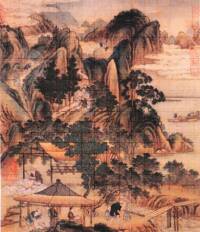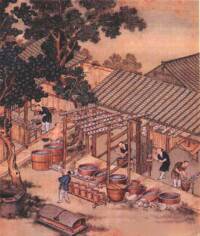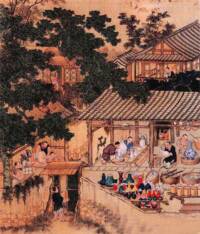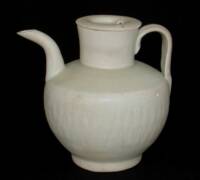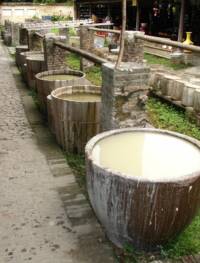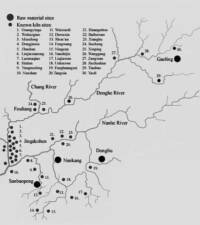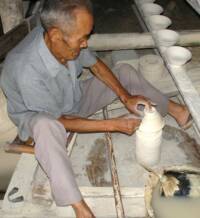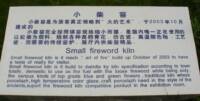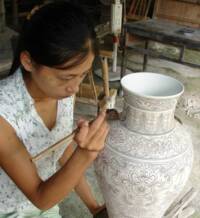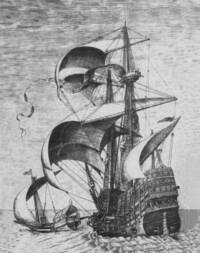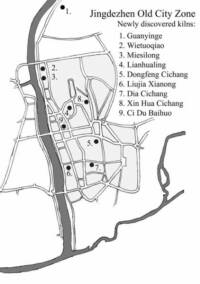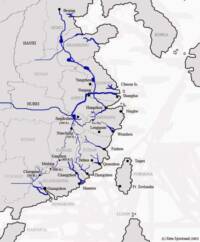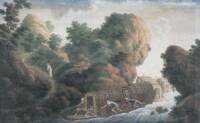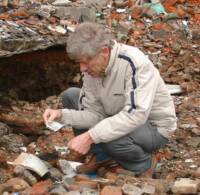Jingdezhen, "The porcelain centre of the world."
A short description of the history, developments, transport and production
of ancient Chinese porcelain.
(Sten Sjostrand)
This text is part of the Wanli shipwreck catalogue: "The Wanli Shipwreck and its Ceramic Cargo"
To view or to order the full (360 page) catalogue please go to: Publications.
Early Production:
Jingdezhen, the ‘city of all day thunder and lightning,’ is located in the northeastern part of Jiangxi province and is known as the porcelain centre of the world. Some historians believe that ceramics production may have started there in the Han dynasty (206 BC.–AD. 220) with kilns spread along the Chang River, south and southeast of the town.(1) The town was then called Xinping Town or Changnan for its location to the south (nan) of the Chang River. Pottery clay was in ample supply all around the town. More specifically, the Gaoling mountain, 40 kilometers to the northeast, is one of the few areas in China which provided pure kaolin, one of the essential ingredients for porcelain. Other nearby areas such as Nankang, Sanbaopeng, Dongliu and Liujiawan provided the other ingredient; the so-called ‘China stone.’
Another important material was fuel for the kilns. Pine wood was found in abundance around the town. The Chang River provided transport for raw material to the kilns as well as for later shipping of the finished products. In summary, the ample clay resources, fuel supply, convenient transportation and eventual imperial favors provided the necessary catalyst for potters from other places in China to join in the commercial pottery production in the town.
Other texts say that pottery was being made at Jingdezhen by A.D. 557 and that it had grown into an industry by Tang dynasty (A.D. 618-906). Old texts mention the Tao kilns, which are said to be named after the Tao family who founded the kilns and who made high-fired pottery already then known to be translucent and often referred to as ‘artificial jade’.(2) In support of this industry, Guangzhou in southern China became a thriving seaport that by the Tang dynasty was home to a large Arab community with its own mosques and trading houses.
By the reign of emperor Jingde (1004-1007) of the Song dynasty (960-1280), the court decreed that existing private kilns fire quality wares for imperial use and that the pieces should be marked with ‘Made in the Jingde period’ on the base. The town (zhen) was thereafter known as Jingdezhen and the earlier name of Changnan was gradually forgotten. This decree did not result in the creation of new kilns but merely appointed established private kilns to add imperial wares to their production. The kilns were thus producing high quality wares for the imperial court at the same time as producing common dinner sets for the domestic markets at the same time.(3)
Tributary pottery for the court, like the thin-walled ‘thin as paper’ or qingbai wares, were made at the Hutian kilns in the northern Song dynasty. By 1278 production at the Hutian kilns was overseen by a government official from the ‘Porcelain Office’ who also overlooked the imperial production at the Luomaqiao kilns and those on the Zhushan hill. Hutian had a great impact on other Jingdezhen kilns which began producing similar quality wares. At this time, it appears certain that imperial wares were not fired in a kiln specially created for that purpose. Instead, after receiving production requirements from the court, Jingdezhen would summon all the best ceramists together to design, choose and fire the best ware possible. (4) (It is likely that this communal corroboration between the different potteries and kilns lasted until at least the 15th century and beyond, when private kilns are known to have assisted official kilns with imperial orders.)
During the Song dynasty high-fired ceramics were immensely popular and developed to perfection. Thousands of pieces were exported annually to the Middle East, India and Southeast Asia. Despite this successful trade, the Song court was forced to exploit every means in order to pay ‘peace money’ to the Mongol invaders and to maintain its own administration and military. Aware of the threats from the invaders and its own diminishing empire and lack of finances, the court decided to increase its revenue by increasing foreign trade. One of these measures was to establish Superintendents of Shipping offices and sponsoring of overseas trade. In combination with active sponsorship, this trade would greatly benefit the Chinese economy and spur the industrialization of the potteries at Jingdezhen. These late Song dynasty Superintendents offices were thus established at Guangzhou in the south, Hangzhou in Zhekiang province and Quangzhou in Fujian province.
Although large quantities of Chinese pottery were exported to Southeast Asia, India and the Middle East from the 9th century, it was the Yuan dynasty (1280-1368) under the rule of Kublai Khan that significantly expanded maritime trade. During the Mongol invasion of northern China it would appear that Cizhou potters from present-day Cixian of Handan municipally, Hebei province migrated to the south and assisted in the technical and decorative achievements of porcelain making in Jingdezhen. (7) The technique of painting with iron black oxides before glazing, so long practiced elsewhere in China, may have given birth to the first cobalt decorated wares of Jingdezhen, although underglaze cobalt decorated wares from the Gongxian kiln in Henan are known from Tang times. (8) This politically motivated transfer of technology resulted in the best known ceramics of all time - blue and white porcelain. It also had a fundamental effect on Jingdezhen production, China’s trade and eventually on the whole world, although its full impact would not be seen until the fourteenth century.
During the Yuan dynasty the Chinese potters introduced new forms and painted the earliest known untraditional Chinese motifs on high quality porcelain for foreign dignitaries. Porcelain that was customized to suit the needs of the Middle East included large plates with Islamic motifs. Shards from such plates, excavated from the original Yuan dynasty official kilns, are not imperial in form although the body and glaze are clearly of imperial quality. This type of early export ware was reportedly not made before 1328, and the ware was not made after 1352. The earlier date is based on excavations at the kiln sites where the painted pattern was not seen before this date. (9) The later date marks the future Hongwu emperor’s conquest of the area and the subsequent cessation of production. Professor Liu Xinyuan who excavated the kilns re-affirmed that shards from such large plates, excavated from these kilns are not Chinese but more suited for the Islamic markets. (10)
The official kilns did however seem to have flourished during these times. In the early Ming dynasty another 20 kilns in Jingdezhen were recognized for their quality wares and commissioned to produce ‘imperial porcelain’ exclusively for the court. These kilns were set up next to an ‘imperial depot’ in 1425 which was to assemble, store and arrange transport to Beijing and the imperial palace.
While production for overseas markets was reduced, private kilns in Jingdezhen made blue and white porcelain for the huge domestic market. Work for the official kilns was increased in 1433 when the Ming court ordered 443,500 pieces of porcelain for the imperial household. To fill this order, the number of official kilns was increased to 58. In addition to the added production capacity, which probably came from up-grading previously private kilns, privately owned kilns assisted with the production of standardized wares. Official kilns continued to make the finer wares. The 1433 order, as with most other imperial orders, was overseen by eunuch commissioners appointed by the court. (14) Imperial orders in 1529 were limited to 2,570 pieces, but they gradually increased to 174,700 pieces in 1577. (15) Private kilns that assisted with imperial production are thought to have been allowed to sell off rejected imperial pieces provided none bore the emperor’s reign mark. (16)
The ‘flesh and bones’ of porcelain were two components mixed in different proportions depending of the type of ware desired. The first of the ingredients is kaolin, a pure white clay formed by the decomposition of aluminum silicates, in particular decomposed feldspar. Kaolin remains white when fired, but its low plasticity makes it difficult to pot. The clay is quarried in open mines and washed in a series of ponds where the finer particles are separated from heavier impurities. Only the upper supernatant fluid was allowed into a second and a third pond before the clay was dried and made into bricks. The word kaolin derives from the Gaoling (‘High Ridge’) hill 40 kilometers northeast of Jingdezhen where the clay was first found.
The ‘bones’ in porcelain is China stone (petuntse), a granitic grayish white stone which still retains much unaltered feldspar, quartz and sericite. After being pulverized by water driven pestles, the powder from the stone is also washed in successive ponds and then dried into bricks. This material, by itself, can be fired only to about 1,150˚ Centigrade and is off-white in color. The kaolin-petuntse mixture, however, is white and plastic and when used with for blue and white wares, is fired at 1,250-1,330˚ Centigrade.
Both materials were quarried in mines outside Jingdezhen by specialized mills and transported by river boats to the potteries. It is believed that very few expert suppliers of kaolin and China stone were in operation during the Ming dynasty, although a Qing dynasty treatise on porcelain of 1815 indicates that there were 28 rapids, each of them with water-driven pestles, east of Jingdezhen.
At the potteries the two different clay bricks were mixed with water and stirred to a homogeneous texture before storage in earthenware jars. The proportions of the two substances depended on the type of ware to be made. For finer wares, more kaolin was required; this allowed the shape to remain secure during firing. On the other hand, petuntse was required for translucency, so characteristic for porcelain. After deciding the mixture, which no doubt also considered the price for the two materials, the ready slurry was screened though horsehair sieves and then through silk bags to separate the finer particles from the coarser. The surface water was emptied from the jars, and the bottom paste was left to solidify. After drying, the clay was placed in pits or on stone slabs and stamped on by men or oxen and kneaded until the mixture was compact. Once it was allowed to age, the ready clay received a final wash and further kneading to rid it of air bubbles before it was ready for throwing on the wheel. Even at the wheel, it was again kneaded and sized by the potter’s assistant, working next to the potter, before it was shaped into pots.
After the pots were trimmed and allowed to dry, skilled artisans would decorate them. Outlines, for instance, could be drawn in darker cobalt mixture before other decorators used different shades of blue to fill in the design. (17) After the painted decoration was applied, the foot-ring was carved and circular rings were painted onto the base while the pot was still on the wheel. Other craftsmen would then apply reign marks or an inscription within the rings. Some pieces of porcelain from The Wanli Shipwreck included the circular outlines on the base but no markings within them. These must have by-passed the decorator who was supposedly meant to fill them. Yet other kraak plates by-passed the artisans supposed to paint the fill in the main decorations.
After their decoration, the pots were glazed with a thin layer of specially prepared slurry containing fern ash. This glaze mixture was delivered to the kilns in Jingdezhen as a liquid by specially lined river boats. When the pots were glazed and dried, the painted decoration disappeared under the whitish slurry, but reappeared after firing as crystal blue below transparent glaze.
Chinese tradition claims that the earliest cobalt at Jingdezhen was imported from Persia. This ore was rich in iron. Later cobalt oxide, high in manganese, mined in China was utilized, sometimes in varying mixtures with imported cobalt.
Once the pots were decorated and glazed, most private workshops sent them to kilns that specialized in firing ceramics. The pots were carried on wooden planks added in layers to a ladder-like structure. The early matiyao kilns were commonly built on the slope of hills in an area that was not necessarily suited to workshops. From the 16th century, egg-shaped kilns (zhen yao) or mantou type kilns become more popular as they and the later ‘beehive’ kilns could be constructed on flat ground.
(1) It is recorded in the History of Fuliang County that “Xinping began to fire pottery in the Han dynasty” and from Notes on South Kilns in the Qing dynasty that “Jingdezhen Town in Xinping is located to the south of the Chang River and pottery wares were made there from the Han times.” See Liu Xinxin, The Prosperity and Characteristics of Qingbai Porcelain in the Song Dynasty, in Chai Kiln & Hutian Kiln, 2004, p. 45. (Publisher etc. in Chinese only. ISBN 7-80674-591-2.)
(2) Liu Xinxin, ibid., p. 45.
(3) Liu Xinxin, ibid., p. 21.
(4) Liu Xinxin, ibid., p. 21.
(5) Liu Xinxin, ibid., p. 45.
(6) A.C. Moule and Paul Pelliot, Marco Polo: The Description of the World. London,1938, p. 352.
(7) Liu Xinxin, op. cit., p. 45. Also see S. T. Yeo and Jean Martin, Chinese Blue and White Ceramics –a brief Introduction.  Singapore. Art Orientalis, 1978. p. 16.
Singapore. Art Orientalis, 1978. p. 16.
(8) Nigel Wood, Chinese Glazes. London: A&C Black Limited, 1999, p. 97.
(9) Professor Liu Xinyuan, personal discussions, August 2005.
(10) Liu Xinyuan, Imperial Export Porcelain from late Yuan to Early Ming, Oriental Art Magazine, Volume XLV/I (1999) pp. 98-100. Personal discussions, August 2005.
(11) S. T. Yeo and Jean Martin, op. cit., p. 20.
(12) See Roxanna M. Brown, The Ming Gap and Shipwreck Ceramics in Southeast Asia, PhD dissertation, University of California at Los Angeles, 2004.
(13) Wu Zhenglian, The Verification of Merchant Ships types in the Sino-Japanese Trade from the end of the Ming Dynasty to the Beginning of the Qing dynasty, Proceedings of the International Sailing Ships History Conference. Shanghai, 1991, p.143.
(14) Kee Ming-Yuet. Straits Chinese Porcelain. Kuala Lumpur: Kee Ming-Yuet Sdn. Bhd. and Cross Time Matrix Sdn Bhd, 2004, p.189.
(15) Colin Sheaf and Richard Kilburn, The Hatcher Porcelain Cargoes, The Complete record. Oxford: Phaidon Christie’s Limited, 1988, p. 21.
(16) Sheaf and Kilburn, ibid., p. 22.
(17) It is interesting to see how Pere’ d’ Entrecolles in his letters of 1712, rate these decorators: “ In Europe they would only pass for apprentices of a few month’s standing….They know nothing of the beautiful
rules of this art; though it must be acknowledged that they paint flowers, animals, and landscapes which are much admired, on porcelain as well as on fans and lanterns of the finest gauze” See; William Burton, Porcelain, It’s Art and Manufacture, B.T. Batsford, London, 1906.
(18) B.T. Batsford, ibid., p.43.
(19) Tang Yings alias Jun Gong, a native from Han Jun Qi was serving as Deputy Officer of the Internal Affairs Office in the Hall of mental Cultivation of the Royal Palace. In the 6th year of Yongzhen reign (1729) he was decreed to supervise the Imperial porcelain production at Jingdezhen. In 1743, he submitted his famous: Twenty Illustrations of Porcelain Manufacturing to the emperor together with detailed description of porcelain production. Although the report is widely reprinted, the most authentic version can be found in the official annals of the province of Jiangxi; Book XCIII, Folio 19-23. Private translation is made by Dr. Tan Pek Hong. Kuala Lumpur, 2006.
(20) Maria Antonia Pinto de Matos, The Portuguese Trade, Oriental Art Magazine, XLV/1 (1999) p. 22.
(21) Maria Antonia Pinto de Matos, ibid., p. 22.
(23) Peter Borschberg, The seizure of the Sta. Catarina revisited: The Portuguese Empire in Asia, VOC politics and the origins of the Dutch-Johor alliance (1602-c.1616). Journal of Southeast Asian Studies; 2/1/2002. p. 5.
(24) T. Volker, Porcelain and the Dutch East India Company. Leiden: E.J. Brill, 1954.
(25) Sheaf and Kilburn, op. cit., p. 21.
(26) T. Volker, op. cit., p. 42
(27) T. Volker, op. cit., p. 69.
(28) T. Volker, op. cit., p. 67.
(29) Professor Liu Xinyuan, personal discussions, August 2005.
(30) C. Vialle’, The records of the VOC concerning the trade in Chinese and Japanese porcelain between 1634 and 1661, Aziatische Kunst, XXXll/3, Amsterdam (1992) pp.7-34.
(31) Cao Jianwen, Jingdezhen Ceramic Institute, The Relation between Ceramics Production in Jingdezhen during Late Ming Dynasty Ceramics found on ‘Wanli Shipwreck’ in Nanhai. A report on The Wanli Shipwreck at the ‘Treasures of the Nanhai” Exhibition. Kuala Lumpur Sept. 2005.
(32) Geoff Wade, translator, Southeast Asia in the Ming Shi-lu: an open access resource, Singapore: Asia Research Institute and the Singapore E-Press, National University of Singapore, http://epress.nus.edu.sg/msl/entry/586, accessed October 14, 2005.Geoff Wade, translator, Southeast Asia in the Ming Shi-lu: an open access resource, Singapore: Asia Research Institute and the Singapore E-Press, National University of Singapore, http://epress.nus.edu.sg/msl/entry/586, accessed October 14, 2005.
(33) Based on studies of the Dutch Daghregister, Bennet Bronson ascertains that seaports in Fujian exported more ceramics than Guangdong in the years between 1673 and 1683. See Bennet Bronson, Export Porcelain in Economic Perspective: The Asian Ceramic Trade in the 17th century, in Chuimei Ho, editor, Ancient Ceramic Kiln Technology in Asia. Hong Kong: University of Hong Kong Centre of Asian Studies (1990) pp. 126-151. In his paper Quantifying the Role of Fujian Ceramics in China’s Southeast Asian Trade (1998) p. 3. Bronson adds that more ships departed from Macao and Guangdong but the size of the ships from Fujian ports was larger.
(34) Cao Jianwen and Luo Yifei, Kraak Porcelain Discovered at Some Kiln Sites in Jingdezhen City Recently years. Unpublished report, February 2005.
Most clay material was collected, washed and made into bricks in the mountains outside Jingdezhen before it was transported to the potteries.
Copyright (c) (2007) Sten Sjostrand
This above text is part of the Wanli shipwreck catalogue: "The Wanli Shipwreck and its Ceramic Cargo"
To view or to order the full (360 page) catalogue, please go to: Publications
During the 13th century many other kilns were spread out over a large area southeast of the town. The author visited the excavation of an early Song dynasty kiln 40 kilometers west of the Chang River in August 2005. These remotely located kilns do however appear to have moved closer to the city center by the Yuan dynasty, possibly in connection with increased overseas trade. It is reported in the Yuan-dynasty Notes of Ceramics by Jiang Qi that “All together there were over three hundred kilns in Jingdezhen." Wares made in these kilns were white, clean and flawless. When sold in other provinces in China, people called them ‘jades’. (5)
At the potteries the clay was again mixed and made into pots of various type and shapes.
By the time the Mongols had established the Yuan dynasty (1280-1368), trade flourished. The seaports established by the Song court became even more successful under Mongol rule. Marco Polo (1275-1292) wrote that Quanzhou harbor was the greatest port in the world and also mentioned the ceramics trade:
After drying, the pots were painted with cobalt oxide which appeared dark blue after the glaze surface had crystalized during the firing.
Jingdezhen porcelain, ancient Jingdezhen kilns, Ming porcelain from Jingdezhen, The porcelain centre of the world, Jingdezhen porcelain production,
A qingbai type ewer from the 11th century Tanjung Simpang shipwreck
At the kiln, the pieces of pottery were placed in saggars, specially-made circular boxes, to ensure they received uniform temperature and to protect them from air currents and debris that might fall from the kiln ceiling. The arrangement of the saggars in the kiln took into account the heat requirements for the different types of ware. Observers in the 18th century report that it took about eight days to reach the required temperature. A kiln master determined the temperature by observing the color of the saggars. When they reached silver-red, the fire was stopped. Even though three to four days was allowed for initial cooling, the saggars as well as the kiln interior were still very hot when special workmen covered in wet cloth removed them. The difficulties in determining kiln temperature and related risks are described in Pere’ d’Entrecolles letter of 1712:
“……the whole oven-full is hardly ever successful. Sometimes it is quite lost, and when they open the furnace they find the porcelain pieces and the cases (saggars) are reduced to a mass as hard as rock…. For one workman who gets rich there are hundred others who ruin themselves, though 

 they still try their fortunes further in the hope that they may save enough to become shopkeepers”. (18)
they still try their fortunes further in the hope that they may save enough to become shopkeepers”. (18)
A word of caution is in place here. When referring to ‘kilns’ it is perhaps common to assume a place where the pots were made, decorated, glazed and fired. This may not be true for the export production as there were relatively few ‘kilns’ but many small potteries scattered all over the town. It is therefore possible that future archaeology will discover actual kilns, specialized in firing the ware, while other places may yield evidences of porcelain production.
These separate production segments are probably confirmed by Tang Ying, alias Jun Gong, who was decreed to supervise porcelain production in Jingdezhen during the early 18th century. His detailed description of all phases of production includes a statement about making the saggars:
"...In the whole district of Jingdezhen there are only three or four workmen reputed clever at this special handiwork." (19)
Individual owners separated the fired wares into different quality groups and priced the export ware accordingly. First class wares had the brightest color and no kiln defects such as warping; pieces with lower density color became second class. The remainder was sold on the domestic market. Ceramics intended for overseas markets were packed in straw bundles and sent to the river for onward transport. The domestic ware was not packed in straw but tied up in bundles of 30-40 pieces before being distributed.
When the volume of porcelain for export increased during the 17th century, many additional kilns appeared in and around Jingdezhen. There is estimated to have been no less than a thousand kilns at the peak of this period. Most of the kilns were distributed along the eastern side of the Chang River, only a few were located on its western bank. Most private kilns were located along the Taoyang Shisan Li (‘thirteen mile’) road that ran north to south through the old city zone. The official kilns were located at or near Zhushan hill in the old city center.
Continued developments at Jingdezhen during the early Qing dynasty resulted in the finest porcelains ever made – those from the Kangxi (1662-1722) reign. Blue and white porcelains of that time were perfectly potted, fired to perfection, and decorated in sapphire blue against a bright white ground.
Thus, from the Ming dynasty we see superior quality porcelain wares made by specially appointed workshops for the exclusive use of the court. At the same time private kilns produce porcelain for the huge domestic and an ever increasing export market. We see private kilns assisting official workshops with large orders, and official potters and decorators joining the export industry when court orders diminished. This degree of adaptability and outsourcing is unparalleled at any other production place at the time.
The Portuguese buyers:
In time, yet another political situation benefited Jingdezhen. In Europe the Portuguese made technical advances that led to the development of a merchant fleet. And their goal was to purchase spices directly from Southeast Asia rather than via Muslim middlemen in the Middle East and other agents in Italy. As a result of this desire for spices, they found Chinese porcelain first in India and then, after their settlement in Melaka was established in 1511, in China. The first pieces of Jingdezhen ware brought back to Portugal by ship were acquired in India and presented to King Manuel I by Vasco da Gama.
Meanwhile, some of the early Portuguese ‘trade’ in Asia consisted of looting of Arab, Chinese and Indian merchant ships. This approach was not appreciated by the Chinese court which prohibited contact with the newcomers. Nevertheless, the Portuguese managed to order porcelain from Fujian middlemen, and eventually they were forwarding drawings to Jingdezhen for specially designed pieces. The special orders included a blue and white ewer bearing the Portuguese armillary sphere, the emblem of King Manuel I (1495-1521), and various shapes decorated with other coats-of-arms. (20) While the designs were sometimes painted upside-down or misinterpreted in other ways, they show how willing the Chinese potters were to please new customers.
The taste for Chinese porcelain in Portugal and elsewhere in Europe slowly gained popularity during the later part of the 16th century when the Portuguese royalty gifted other European nobilities with this exclusive commodity which they alone could acquire at source. Here it is important to note that Chinese celadon, an important export in earlier times, rarely entered the trade with Europeans. Blue and white porcelain had already become more fashionable than celadon in the 15th century, and the Portuguese arrived at the beginning of the 16th century.
Portuguese praise for Chinese blue and white porcelain can be seen in a letter by Frei Bartolomeu dos Martires who, during a dinner with Pope Pius lV in 1563, compared porcelain to silver tableware:
Large volumes of blue and white porcelain were exported to Southeast Asia during 1328-1352. (11) Whether the Chinese chronicler Wang Ta-yuan’s reports, made during many years of visiting Southeast Asian countries, refer to qingpai as we know it today or blue and white porcelain, the David vases of 1351 confirm that Chinese blue and white porcelain production was well developed by the middle of the 14th century.
China stone from open pits at Sanbaopeng was pulverized by water driven pestles before made into briks and transported to the Jingdezhen potteries.
Shapes like cups and bowls were first thrown on the wheel. After drying, back on the wheel, the leather hard pot was trimmed while careful measurements were taken to check overall diameter, height, thickness and foot-ring details. Upright forms were made in different sections that were luted together by adding clay slurry to the join surfaces. Plates were first thrown on the wheel before pressed to exact size in moulds. These moulds could sometimes have ridges, striations or other impressed designs. An 18th century traveler to Jingdezhen reported, somewhat inaccurately, that these plates were so exact that they did not vary more than a hairbreadth in size. Although this may be true in the 18th century, very few plates in the Wanli 17th century cargo had the same overall or foot-ring diameter.
Location of china stone and kaolin quarries outside Jingdezhen.
Transition to blue and white porcelain:
Jingdezhen porcelain manufacturing:
When the Hongwu emperor, first ruler of the Ming dynasty (1368-1644), prohibited the building of ocean going vessels and private overseas trade in 1371, it had a detrimental effect on export production at Jingdezhen. With the exception of increased trade in the time of the fabled Zheng He’s treasure ship voyages, very few ceramics were officially exported from China between the third quarter of the 14th and the late 15th century. (12) There was however substantial smuggling despite the ‘Ming ban.’ One text states that when “not a single board was allowed to put out to sea, some renowned families at coastal areas built naval [narrow and fast ships] vessels without permission. They sailed away to do business in many foreign countries every year.” (13)
Signboard at a modern kiln at Jingdezhen explaining it all !?
"Reproductions" employ many potters in today's Jingdezhen
The quality of the Jingdezhen porcelain does however fall into two distinct basic groups. One was made strictly for the imperial court and the other for the domestic and export markets. Because imperial ware was made to strict specifications, personal artistic expression by the decorators was not only minimized but simply not allowed. As a consequence of strict quality control, imperial porcelain may tend to appear artistically lifeless but is famous for its technical qualities. Private kilns, on the other hand, made whatever form and decorative styles were in fashion and acceptable to foreign buyers. On these wares individual decorators display their own styles of painting based on personal interpretation of traditional motifs, making them lively, innovative and individual.
It is unfortunate that export wares have been described as ‘provincial’ or even ‘unrefined,’ which suggest the pots were made in a different area than Jingdezhen and that private potteries were unable to produce quality ware. The truth is that the two categories of ware satisfied specific markets. The private potters and decorators, as enterprising then as now, simply adapted a flexible market strategy for niche markets. If freely sketched motifs and thick bodied ceramics mean they are ‘unrefined’, they certainly are not ‘provincial’ in any way.
"In Portugal we have a kind of tableware which, being made of clay, may be compared advantageously to silver both in its elegance and its cleanliness, and I would counsel all princes to use it in preference to any other service and to banish silver from their tables. In Portugal we call it porcelain. It comes from India and is made in China. The clay is so fine and transparent that the whites outshine crystal and alabaster, and the pieces which are decorated in blue dumbfound the eyes, seeming a combination of alabaster and sapphires. They are not concerned about their fragility since they are quite cheap. They may be esteemed by the greatest princes for their delight and curiosity, and this is why we have them in Portugal. (21)
"The most beautiful vessels and plates of porcelain, large and small, that one can describe are made in great quantity…more beautiful than can be found in any other city. And on all sides they are much valued, for none of them are made in another place but in this city and from there they are carried to many places throughout the world. And there is plenty there and the great sale, so great that for one Vientiane goat you would actually have three bowls so beautiful that none would know how to devise then better". (6)
This situation was also witnessed by the Arab traveler Ebn-e-Batuteh (1304-1378) who reportedly saw over a hundred big ships and innumerable smaller ships in Quangzhou harbor.
Centuries after Marco Polo praised Chinese ‘porcelain’ and remarked on the large volume of export, Father Matteo Ricci, writing about China in the period of his residency there (1582-1610), noted:
Click here to add text.
"The finest specimens of porcelain are made from clay found in the province of Jiangxi, and these are shipped not only to every part of China but even to the remotest corners of Europe where they are highly prized by those who appreciate elegance at their banquets rather than pompous display. This porcelain too, will bear the heat of hot foods without cracking and, what is more to be wondered at; if it is broken and sewed with brass wire it will hold liquids without any leakage." (22)
It is difficult to ascertain the volume of Jingdezhen porcelain intended for the European market in the later part of the 16th century due to lack of records. However, in the early 17th century when the Portuguese carrack Santa Catarina was captured by the Dutch there were more than thirty last (sixty tones) or about 100.000 pieces of porcelain in her holds. (23) When later auctioned in Holland it started a Dutch craze for Chinese porcelain. Its fame spread to the rest of Europe by the second half of the century.
The Dutch buyers:
Export production at Jingdezhen witnessed yet another boost when the Dutch arrived in China in the early 17th century. With the Portuguese well established in Macao, the doorstep to China, the Dutch had repeated disputes with the Portuguese and the Chinese administration. Misbehaving, as the Portuguese did before them, the Dutch were forced to trade along the Chinese coast and from various illegal settlements with primarily Fujian merchants. The difficulties the Dutch had in establishing direct trade with the Jingdezhen potteries is reflected in a letter by Kr. Kohn, an officer of the Dutch VOC company in 1616:
"These porcelains sold to us were produced in an inland kiln which was very far away, and those porcelain need to be ordered and paid in advance." (24)
From their various illegal bases on China’s coast, on Taiwan, and at later establishment in Japan, the Dutch had to wait a full year for their deliveries. Yet, despite the distance and with unprecedented trust in the Chinese middlemen, the Dutch alone already in 1608 ordered more than 108,000 pieces of porcelain, a number that grew to 355,800 pieces in 1644, for the European market alone. (25)
Following the sale of the porcelain cargo from Santa Catarina, it has been estimated that between at 1604 and 1657, more than three million porcelain pieces were shipped to Europe by the Dutch alone. (26) Adding the even higher volume of porcelain for Southeast Asian markets, the total production at Jingdezhen was staggering.
The Dutch, as the Portuguese before them, relied on standard types of ware with standard decorations but often complained about the quality. In 1618 the Dutch officers of the VOC company in Surat complained about a Portuguese advantage:
"Your Honour forwards to us of the other kinds should be just right and good, because it will be judged for these qualities, as the Portuguese carry hither extra-ordinary fine and exquisite wares, so much so that our fine is coarse when compared with theirs." (27)
A 16th century Dutch ship
It was not only better quality the Portuguese managed to secure for themselves. Marked porcelain pieces were not only popular in Europe but also in Southeast Asia and India. Another letter from a VOC official on the Coromandel Coast, dated 1610, complains about the lack of marked pieces delivered by the Chinese:
"It should be seen to that all these afore-noted kinds of porcelain have under the bottom a blue seal, for about this they are very particular." (28)
In the late Wanli (1573-1620) period imperial orders for Jingdezhen had dwindled and normal deliveries to Beijing become risky. At the same time some of the official kilns, were razed during peasant revolts and eventually closed in 1608. (29) With continued economic troubles and lack of imperial orders worsened by the approaching Manchus, the remaining kilns closed and did not re-open until a few years into the Qing dynasty. During this ‘transitional’ period (circa 1620-1663), some private kilns managed to stay in production for an ever increasing export market. Unemployed potters and decorators from the official kilns joined the private kilns and were instrumental in improving production. ‘Transitional’ wares from the 17th century are characterized by fine naturalistic motifs that are painted in brilliant blue cobalt and covered by a clear smooth glaze.
From about 1634 onwards, Chinese junk captains took orders from the Dutch for porcelain in special shapes for which models of European objects were provided. (30) There were also special patterns including ‘Dutch flower-and-leaf work’. Some designs were initially incorporated into typical kraak panels, a practice that shows how the Jingdezhen decorators adopted new motifs to please their buyers.
Until late 1630s the supply of porcelain from Jingdezhen was relatively steady, but in the early 1640s there were reports of war in Jingdezhen and high mortality rates among the potters. Production did however continue, and in large quantities, but supply remained uncertain until about 1657 when the Dutch ordered much of their porcelain in Japan.
All Jingdezhen ceramics began their long journeys on the Chang River loaded on small river boats. The first transit point was at Lake Poyang where the cargo was transferred to larger boats that proceeded through the lake into the Yangtze River and downstream to Nanjing. From there some of the boats followed the Grand Canal and its associated waterways north to reach Beijing -- a hazardous journey of about 1,900 kilometers. Other boats went south on the Grand Canal to reach Hangzhou, a journey of 1,000 kilometers. Other rivers and waterways coupled with some overland transport allowed porcelain cargoes to reach such seaports as Zhangzhou, Quanzhou and Fuzhou in Fujian province, Wenzhou in the Zhejiang province and Changzhou in northern Guangdong province. The most cumbersome but most frequently used route in the 17th and 18th centuries ran from Jingdezhen to Guangzhou (Canton) in southern China. This route began in Lake Poyang and proceeded up the Gan River to Nanchang. Re-loaded onto smaller river boats, the porcelain cargo would then continue upstream to Ganzhou (122 meters above sea level). Continuing on smaller rivers, the cargo boats eventually reached the southern border of Jiangxi province. Here the porcelain had to be hand carried over the Meiling Pass, a stretch of some 30 kilometers that reached about 275 meters above sea level. After the Meiling Pass, the goods was again re-loaded onto small boats that navigated the winding narrow upper reaches of the Bei Jiang River before reaching Guangzhou after a cumbersome, time-consuming journey of about 1,400 kilometers.
River transport was without doubt long and cumbersome. Crews rowed long distances against the current and often used poles to push the heavily loaded boats though shallows and rocky streams. In addition to this work and responsibility, whether they started upstream or downstream, they had to return to their original place of loading before repeating the journey.
With hundreds of thousands of pieces of porcelain transported during most years of the 17th century and many more in the 18th century, the transport of porcelain was another large industry in itself. With large numbers of small boats navigating sometimes small and winding rivers, coming and going, the rivers were both crowded and dangerous, not least for the fragile cargo.
From coastal ports in Zhejiang, Fujian and Guangdong, Ming and Qing dynasty porcelain reached Chinese merchants and shippers who supplied the Spanish in the Philippines, the Portuguese in Guangzhou and Macao, and the Dutch in Taiwan and later Japan. (32) In the early 17th century, when the Fujian people depended in fishing and cargo transport, they were prohibited from building large double-masted ships for fear they might supply the unpopular Dutch in Japan. A special permit, which was often falsified by corrupt officials, was required for smaller ships before they could set sail to foreign countries. Following the fall of the Ming dynasty, this situation reversed. In the late 17th century Fujian ports exported more ceramics than Guangdong. Although Macao and Guangdong saw more ships departing, the Fujian ships were larger. (33) This changed again in the 18th century when almost all porcelain cargo was handled by Hong merchants in Guangzhou, who supplied European ‘factories’ established on the shores of Guangzhou.
Porcelain from the inland kilns at Jingdezhen was delivered to seaports through rivers, lakes and the Grand Canal. The journey could be almost 2,000 kilometres and sometimes included a 30-kilometre trek over the 275-metre high Meiling Pass.
Near the uopper reaches of the Meiling Pass, the boats had to be pushed through the shallows.
Newly discovered private kilns
While many kiln wasters has been found from the earlier production outside Jingdezhen town, increasingly more kilns from the Yuan, Ming and Qing dynasties are now being discovered in Jingdezhen. Most of these are private kilns from the Ming and Qing dynasties.
A number of such export kilns has been investigated by Professor Cao Jianwen and Ms. Luo Yifei from the Jingdezhen Ceramic Institute. (34) These investigations include the Liujia Xianong kiln (2003) and Lianhualing kiln (2005), both situated within the old city zone, Miesilong kiln (2004), and the large Guanyinge kiln complex (2001) which is located north of the old city zone as well as the Dongfeng Cichang (2002-2003) and Xin Hua Cichang kilns just east of the old city zone. These kiln sites provide a wide variety of blue and white kraak ware, thin walled bowls, large diameter bowls ranging from very high quality to medium and low quality. The Lianhualing kiln provided a few shards with a Dutch tulip motif, and Guanyinge and the Liujia Xianong site provided medium sized plates with double deer motifs in the medallion.
Transportation:
The relative ease of transportation on the Chang River and its tributaries was a key circumstance in the successful development of the porcelain industry in Jingdezhen. One Ming official, Miu Zongzhou, wrote that “Kilns are arranged along the rivers and boats and ships which carry porcelain come and go everyday”. (31) Despite Jingdezhen’s location in the remote corner of Jiangxi province, these boats and ships managed to transport huge volumes of ceramics to domestic markets as far away as Beijing as well as to different seaports for shipping overseas.
The author at a newly discovered 16th century kiln site, hidden below a 19th century house foundation.
Directly related to The Wanli shipwreck cargo are porcelain shards collected at the Guanyinge kiln site. These are identical to the delicate, thin-walled underglaze blue and red bowls found in the Wanli shipwreck cargo. In addition to these samples, shards from thin-walled ‘crow’ bowls were also collected.
In March 2005 the author was also privileged to discover other production sites being uncovered when a bulldozer was completing the excavation for the basement of a new building along the 'Thirteen Mile Road.' This site is today known as the Weituoqiao kiln site. The excavated area, four meters deep, with perfectly cut sides, revealed three independent waste piles of Song dynasty coarse secondary clay pottery, finer qingpai shards, and Ming and Qing dynasty export ware. These perfectly cut stratograpic levels were covered by a concrete basement before any recording of the material had taken place.
During the visit and cursory inspections of kiln sites in Jingdezhen, it became evident that wasters from the same site could include a wide array of porcelain. The finest export ware was often mixed with rather crudely potted bowls with an unglazed biscuit ring in the well. These bowls have often been called ‘Guangdong wares’ or more broadly attributed to ‘southern China.’ The array of forms, quality and decorative styles seen at the sites supports the idea of communal kilns that fired many different types of ware, presumably from different potteries. The fact that an exhibition of kiln wasters at the Palace Museum in Beijing in November 2005 displayed shards similar to those seen at Jingdezhen -- which were however attributed to various kiln sites in Fujian – demonstrates the difficulties in determining the origin on some of these types of wares.
There is little doubt that further investigation of these private kilns, and others, would be fruitful and much appreciated. With the continuing demolition of late Qing dynasty buildings, which were constructed on top of old kilns, many more discoveries are due in the near future. However, it is sad, to hear that China’s new economic boom does not provide for the resources for a long-term archaeological program despite the fact that much information about Jingdezhen’s most important industry would be better understood. Simply to be able to document the varying decorative styles on export wares at different times in history is an important art-historical objective.
If we thought that making 'fake' pottery was a new phenomena, it is interesting to see that Perez’ d’ Entrecolle already in his famous letter of 1712 confirmed that the Jingdezhen potters had perfected the “art of imitating old porcelain being passed for being three or four centuries old or at least of the preceding dynasty of Ming”.
As enterprising now as then, Jingdezhen potters are still mining kaolin in the same quarries and pulverizing China stone in the same traditional manner. The potting process, including the application of painted decoration, glazing, and firing in wood-fueled kilns is often identical to old techniques. Porcelain made in this way today is sometimes also being passed as being centuries old.
Sten Sjostrand
BIBIOGRAPHY:
Adhyatman, Sumarah, 1999. Zhangzhou (Swatow) Ceramics Sixteenth to Seventeenth Centuries found in Indonesia. Jakarta:
Ceramic Society of Indonesia.
Aga-Oglu, Kamer, 1975. The Williams Collection of Far Eastern Ceramics, Tonnancour Section. Ann Arbor: University
of Michigan.
Allane, Lee, 1993. Chinese Rugs. London: Thames and Hudson Ltd.
Alves, Francisco, Eric Rieth and Paulo Rodrigues, 1998. The Remains of a 14th Century Shipwreck at Corpo Santo and
of a Shipyard at Praca do Municipio, Losbon, Portugal, Proceedings: International Symposium on
Archaeology of Medieval and Modern Ships of Iberian-Atlantic Tradition. Lisbon, pp. 405-420.
Asian Art Museum, 1982. The Effie B. Allison Collection, Kosometsuke and other Chinese
Blue-and-White Porcelains. San Francisco: Asian Art Museum.
Ayers, John, 2002. Blanc de Chine: Divine Images in Porcelain. New York: China Institute in America.
Bai Ming, 2002. The Traditional Crafts of Porcelain Making in Jingdezhen. Jiangxi, China: Fine Art Publishing House.
Baochang, Geng. 1994 Selection of Plates of Porcelainwares Collected by Jin Ming. Beijing: International Culture Publishing
Corporation
Bell, Christopher, 1974. Portugal and The Quest for The Indies. Great Britain: Barnes and Noble Books.
Birch, Walter De Gray, 2000. The Commentaries of The Great Afonso Dalboquerque, Second Viceroy of India. New Delhi
and Madras: Asian Educational Services, Volume I – IV.
Blumenfield, Robert. H., 2002. Blanc de Chine, The Great Porcelain of Dehua. Berkeley and Toronto: Ten Speed Press.
Boxer, C. R., 1959. The Tragic History of The Sea. Cambridge: Hakluyt Society.
Boyajian, C. James, 1993. Portuguese Trade in Asia under the Habsburgs, 1580-1640. Baltimore & London : The John
Hopkins University Press.
Brigadier, Sara, 2002. The Artifact Assemblage from the Pepper Wreck: An early Seventeenth Century Portuguese
East-Indiaman that Wrecked in the Tagus River. Unpublished Master’s thesis.
Bronson, Bennet, 1990. Export Porcelain in Economic Perspective: The Asian Ceramic Trade in the 17th century, in Ho Chuimei,
editor, Ancient Ceramic Kiln Technology in Asia. Hong Kong: University of Hong Kong Centre of Asian Study.
Brown, Roxanna M., 2004. The Ming Gap and Shipwreck Ceramics in Southeast Asia. PhD dissertation: University of California
Los Angeles.
Brown, Roxanna, and Sten Sjostrand. 2002. Maritime Archaeology and Shipwreck Ceramics in Malaysia.
Kuala Lumpur: Department of Museums and Antiquities.
Bushell, Stephen, 1899. Oriental Ceramic Art. New York: D. Appleton and Co.
Butler, Michael and Wang Qingzheng, 2006. Seventeenth Century Jingdezhen Porcelain from the Shanghai Museum and the Butler Collections.
Shanghai: Art Media Resources Inc.
Butler, Michael, Julia Curtis, and Stephen Little, 2002. Shunzhi Porcelain. Treasures from an Unknown Reign. Alexandria:
Art Services International.
Butler, Michael, Margaret Medley, and Stephen Little, 1990. Seventeenth Century Chinese Porcelain from the Butler Family Collection.
Alexandria: Art Services International.
Butz, Herbert and Masahiko, Kawahara, 1996. Chinesische Porzellane des 17. Jahrhunderts fur Japan.
Berlin: Staatliche Museen zu Berlin.
Cao Jianwen and Luo Yifei, 2005. Kraak Porcelain Discovered at Some Kiln Sites in Jingdezhen City in Recent Years. China:
Unpublished Report.
Cao Jianwen, 2005. The Relation Between Ceramics Production in Jingdezhen during Late Ming Dynasty and Ceramics found
on Wanli Shipwreck in Nanhai. Kuala Lumpur: report presented at the Treasures of the Nanhai Exhibition.
Carswell, John Alexander, 2000. Blue and white Chinese Porcelain Around The World. Chicago: Art Media Resources, Ltd.
Christie’s Amsterdam, 2004. The Fort San Sebastian Wreck. A Sixteenth Century Portuguese Porcelain Wreck off the Island of
Mozambique. Amsterdam: Christie’s International Media Division.
Christie’s Australia, 2004. The Binh Thuan Shipwreck. Melbourne: Christie’s Australia Pty Limited.
Christie’s, 1989. The Peony Pavilion Collection. London: Christie, Manson and Woods Limited.
Clunas, Craig, 1987. Chinese Export Art and Design. London: Victoria and Albert Museum.
Cort, Louise Allison, and Jan Stuart, 1993. Joined Colors; Decoration and Meaning in Chinese Porcelain Ceramics from Collectors in
The Min Chiu Society, Hong Kong. Washington D.C: Smithsonian Institution in association with
Tai Yip Company, Hong Kong.
Crick, Monique, editor, 2001. Taoci No 2 Céramiques du fond des mers Les nouvelles découvertes. Paris : Société Française d’
Étude de la Céramique Orientale.
Curtis, Julia, 1985. Chinese Porcelains of the Seventeenth Century. Landscapes, Scholars’ Motifs and Narratives.
New York: China Institute in America.
Curtis, Julia, 2006. Trade Taste and Transformation. Jingdezhen Porcelain for Japan, 1620 – 1645.
New York: China Institute in America.
Curtis, Julia, and Stephen Little, 1995. Chinese Porcelains of The Seventeenth Century; Landscapes, Scholars Motifs and Narratives.
New York: China Institute.
Danvers, F. C., 1894. Portuguese In India. London: W. H. Allen and Co.
Davison, Gerald, 1994. The Handbook of Mark on Chinese Ceramics. London: Han-Shan Tang Books.
Desroches, Jean Paul, Gabriel Casal, and Franck Goddio, 1996. Treasures of The San Diego. Manila: National Museum of
the Philippines.
Dimand, M. S., 1947. A Handbook of Muhammadan Art. Second edition Revised and Enlarged. New York: Hartsdale House.
Elisseeff, Radime, 2000. The Silk Roads Highways of Culture and Commerce. Paris: UNESCO and Bergham Books.
Esterhuizen, L.V., 1999. Chinese porselein afkomstig van Portugese skeepswrakke aan die Suid-Afrikaanse kus, 1552-1647
(Chinese ceramics from Portuguese shipwrecks of the South African coast, 1552-1647), South African
Journal of Cultural History, 11/2 (November): 1-22.
Esterhuizen, L.V., 2000. Chinese Ming blue and white porcelain recovered from 16th and 17th century Portuguese
Shipwrecks on the South African Coast, Taoci Revue Annuelle de la Societe Francaise d' Etude de la
Ceramique Orientale, I:93-99.
Esterhuizen, 2001. History written in porcelain sherds: Two early Portuguese shipwrecks off the South African coast São João,
1552 and the São Bento, 1554, Taoci Revue Annuelle de la Société Française d’Étude de la Céramique
Orientale, No. 2: 111-116.
Fang Jing Pei, 2004. Symbols and Rebuses in Chinese Art. Figures, Bugs, Beasts and Flowers. Berkeley: Ten Speed Press.
Feng Hsien-Ming, 1967. Chinese Translation No.1 Important Finds of Ancient Ceramics Since 1949 in Wen Wu, 1965, No.9,
pp 26-56, report translated by Hin Cheung Lovell. London: The Victoria & Albert Museum in association
The Oriental Ceramic Society.
Feng Lili, 2002. Jingdezhen Minyao. Beijing.
Ferguson, Patricia, 2003. Cobalt Treasures, The Bell Collection of Chinese Porcelain. Toronto: Gardiner Museum
of Ceramic Art.
Fujian Provincial Museum and Fung Ping Shan Museum, 1990. Dehua Wares. Hong Kong: Fung Ping Shan Museum.
Goddio, Franck, 1988. Discovery and Archaeological Excavation of a 16th Century trading Vessel in the Philippines.
Manila: World Wide First.
Goddio, Franck, 1997. Weisses Gold. Gottingen: Stiedl Verlag.
Green, Jeremy N, 1986. The Survey of the VOC fluit Risdam (1727), Malaysia, The International Journal of Nautical
Archaeology and Underwater Exploration, 15/2: 93-104.
Gyllensvard, Bo, 1990.  Porslinet fran China. Vasteras: En Tusenarig Exportvara ICA Bokforlag.
Porslinet fran China. Vasteras: En Tusenarig Exportvara ICA Bokforlag.
Hall, Kenneth R., 1985.  Maritime Trade and State Development in Early Southeast Asia. Honolulu: University of Hawai’i Press.
Maritime Trade and State Development in Early Southeast Asia. Honolulu: University of Hawai’i Press.
Harrison-Hall, Jessica, 2001. 

 Catalogue of Late Yuan and Ming Ceramics from the British Museum.
Catalogue of Late Yuan and Ming Ceramics from the British Museum.
Harrisson, Barbara, 1979. 


 Swatow in Het Princessholf. Leeuwarden, The Nerterlands: Gemeentelijk Museum Het Princesseholf.
Swatow in Het Princessholf. Leeuwarden, The Nerterlands: Gemeentelijk Museum Het Princesseholf.
Harrisson, Barbara, 1981. Kraak Porcelain an Introduction with 12 Examples. Leeuwarden: Gemeentelijk Museum Het
Princessholf.
Harrisson, Barbara, 1986. Asian Ceramics In The Princesshof. Leeuwarden: Princesshof Museum.
Hean Tatt Ong, 1999. Chinese Plant Symbolism, a Guide to the Symbolic Value of Plants in Chinese Culture.
Malaysia: Pelanduk Publication. M. Sdn. Bhd.
Ho Chuimei. 1994. The Ceramics Trade in Asia, 1602-82, in Latham, A.J.H. & Heita Kawakatsu, editors, Japanese Industrialization
and the Asian Economy. London and New York: Routledge.
Hobson, R. L., 1983. The Wares of The Ming Dynasty. Tokyo: Charles E. Tuttle. Previous editions 1923, 1962.
Hunter, W. W., 1899-1900. A History of British India. London: London, New York: Longmans, Green, and Co.
Jenyns, Soame 1967. The Chinese Porcelains in the Topkapu Saray, Istanbul,. Transactions of the Oriental Ceramic
Society, 36: 43-72.
Jiangxi Provincial Museum and Chinese University of Hong Kong, 2002. Yuan and Ming Blue and White Wares from Jiangxi.
Hong Kong: Jiangxi Provincial Museum and the Art Museum and Chinese University of Hong Kong.
Jingdezhen Institute of Ceramic Archaeology and The Fung Ping Shan Museum, 1992. Ceramic Finds from
Jingdezhen Kilns. Hong Kong: Fung Ping Shan Museum.
Jorg, Christiaan, 1982. Porcelain and the Dutch China Trade. The Hague: Martinus Nijhoff.
Jorg, Christiaan, 1993. Porcelain for the Dutch in the Seventeenth Century: Trading Networks and Private
Enterprise, in Rosemary E. Scott, editor, The Porcelains of Jingdezhen. Colloquies on Art and Archaeology
in Asia No. 16. London: Percival David Foundation.
Jorg, Christiaan, 1997. Chinese Ceramics in the Collection of the Rijksmuseum, Amsterdam. The Ming and Qing Dynasties.
London: Rijksmuseum, Amsterdam and Philip Wilson Publishers Limited.
Kee Ming-Yuet, 2004. Straits Chinese Porcelain. Kuala Lumpur: Kee Ming Yuet Sdn Bhd and Cross Time Matrix Sdn Bhd.
Kerr, Rose, 1991. The T. Tsui Gallery of Chinese Art: Chinese Art and Design. London: Victoria and Albert Museum.
Kilburn, Richard, 1981. Transitional Wares and their Forerunners. Hong Kong: The Oriental Ceramic Society of Hong Kong.
Kirkman, James, 1958. The Great Pillars of Malindi and Mambrui, Oriental Art, IV/2 (Summer): 55-67.
Krahl, Regina, 1986, Chinese Ceramics in the Topkapi Saray Museum, Istanbul. A Complete Catalogue.
London: Sotheby Parke Bernet.
Krahl, Regina editor, 1995. The Emperor’s Broken China. Reconstructing Chenghua Porcelain. Hong Kong: The Jingdezhen Ceramic
Archaeological Research Institute and Sotheby’s.
L’Hour, Michel, Luc Long, and Eric Rieth, 1989. Le Mauritius, La Memoire Engloutie. Grenoble: Casterman.
Lam, Peter Y.K. editor, 1996. A Legacy of the Ming. Ceramic Finds from the Site of the Ming Palace in Nanjing. Hong Kong:
Nanjing Museum and Art Museum, The Chinese University of Hong Kong.
Latham, A.J.H and Kawakatsu, Heita editors, 1994. Japanese Industrialization and the Asian Economy.
London: Routledge
Li He, 1996, Chinese Ceramics, The New Standard Guide. London: Thames and Hudson.
Lion-Goldschmidt, Daisy, 1978. Ming Porcelain. London: Thames and Hudson.
Lion-Goldschmidt, Daisy, 1986. Ming Porcelains in the Santos Palace Collection, Lisbon.
Transactions of the Oriental Ceramic Society 1984-1985 , 49: 79-93.
Little, Stephen 1983. Chinese Ceramics of the Transitional Period: 1620 – 1683. New York: China Institute in America.
Little, Stephen, 1988. Realm of the Immortals. Daoism in the Arts of China. Cleveland: Cleveland Museum of Art.
Liu Xinxin, 2004. The Prosperity and Characteristic of Qingbai Porcelain in the Song Dynasty, in Chai Kiln & Hutian Kiln.
China: in Chinese. ISBN 7-80674-591-2.
Liu Xinyuan, 2005. Imperial Export Porcelain from Late Yuan to Early Ming. Oriental Art, XLV/I: 98-100.
Loviny, Christophe, 1996. The Pearl Road Tales of Treasures Ships in The Philippines. Manila: Christophe Loviny.
Macintosh, Duncan, 1997. Chinese Blue and White Porcelain, 3rd edition. Hong Kong: Antique Collectors Club Limited.
Maggs, T, 1984. The Great Galleon Sao Joao: Remains from a Mid-16th Century Wreck on the Natal South Coast,
Archaeological Papers from the Annuls of the Natal Museum, 26/1: 173-186.
Manquin, Pierre-Yves, 1980. The Southeast Asian Ship: An Historical Approach, Journal of South-East Asian Studies, 11/2: 266-76.
Marchant, S., and Son, 1983. Exhibition Of Chinese Blue and White Wanli to Kang Hsi. London: S. Marchant and Son.
Marchant, S. and Son, 1989. Exhibition of Transitional Wares for the Japanese and Domestic Markets. London: S. Marchant and Son.
Marchant, S. and Son, 2004. Exhibition of Ming Blue and White: Jiajing – Chongzhen including Dated Examples.
London: S. Marchant and Son.
Mathers, William M, 1990. Nuestra Senora de la Concepcion, National Geographic. 178/3 (September): pp ??? [2]
Mathers, William M., and Nancy Shaw, 1993. Treasure of The Concepcion. Hong Kong: APA Publication (HK) Ltd.
Medley, Margaret, 1961. A Group of T’ien-Ch’i Porcelains in the Percival David Foundation. Oriental Art,
VII/2 (Summer): 81-85.
Medley, Margaret, 1999. The Chinese Potter: A Practical History of Chinese Ceramics. London: Phaidon Press Limited.
Meilink-Roelofsz, M. P. A., 1962. Asian Trade and European Influence in the Indonesian Archipelago between 1500
and about 1630. The Hague: Nijhoff.
Moule, A. C. & Paul Pelliot, 1938. Marco Polo: The Description of the World. London: Routledge and Sons.
Mudge, Jeane McClure, 1986. Chinese Export Porcelain in North America. New York: Clarkson N. Potter, Inc.
Myrtle, Hepburn, 1980. Late Chinese Imperial Porcelain. New South Wales: Art Gallery.
National Museum of Vietnamese History, 2004. Gom Su Thoi Minh, The Ming Dynasty’s Ceramics
at the National Museum of Vietnamese History. Hanoi: National Museum of Vietnamese History.
Nguyen Dinh Chien, 2002. The Ca Mau Shipwreck 1723-1735. Ha Noi: Museum of History.
Oriental Ceramic Society of Hong Kong, 1984. Jingdezhen Wares. The Yuan Evolution.
Hong Kong: Oriental Ceramic Society of Hong Kong and the Fung Ping Shan Museum.
Pearson, M. N., 1994. The Portuguese in India. Cambridge: University Press.
Pierson, Stacey 2001. Designs as Signs: Decoration and Chinese Ceramics. London: Percival David Foundation.
Pinto de Matos, Maria Antonia, 1996. Chinese Export Porcelain from the Museum of Anastacio Goncalves, Lisbon. London: Philip Wood.
Pinto de Matos, Maria Antonia, 1999. The Portuguese Trade, Oriental Art, XLV/1 (Spring)
Pope, John Alexander, 1956. Chinese Porcelains from the Ardebil Shrine. Baltimore: The Lord Baltimore Press Inc
Pope, John Alexander, 1981. Chinese Porcelain From The Ardebil Shrine. Great Britain: Sotheby Parke Bernet.
Qing, Mu and Yang, Weijian 2000. Mingdai Minyao Qinhua (Ming Dynasty Blue and White Porcelain from Local Kilns).
China: Shijiazhuang.
Qingzheng, Wang 1987. Underglaze Blue and Red. Hong Kong: The Woods Publishing Co.
Qingzheng, Wang, 2002. A Dictionary of Chinese Ceramics. Singapore: Sun Tree Publishing Limited.
Quellmalz, Carl Robert, 1972. Chinese Porcelain excavated from North American Pacific Coast Sites,
Oriental Art. XVIII/2 (Summer): 148-154.
Ray, Himanshu P., and Jean-Francois Salles, editors, 1996. Tradition and Archaeology, Early Maritime Contacts in The Indian
Ocean. New Delhi: Manohar Publishers and Distributors.
Reid, Anthony, 1979. Trade and State Power in 16th and 17th Century Southeast Asia, in Proceedings Seventh International
Association of Historians of Asia Conference, 391-419. Bangkok.
Reid, Anthony and Lance Castles, editors, 1975. Pre-Colonial State Systems in Southeast Asia.
Kuala Lumpur: Council of the Malaysian Branch of the Royal Asiatic Society
Rinaldi, Maura, 1989. Kraak Porcelain, A Moment in The History of Trade. London: Bamboo Publishing Ltd.
Rivers, P.J., 2004. 1421 Voyages Fact and Fantasy. Malaysia: Perak Academy Ipoh.
Sassoon, Caroline, 1978. Chinese Porcelain Marks from Kenya. British Archaeological Research
International Series (Supplementary) 43.
Schmidt, Ulrich, 1990. Porzellan aus China und Japan. Berlin: Dietrich Reimer Verlag Berlin.
Scott, Rosemary and John Guy, 1994. South East Asia and China: Art Interaction and Commerce.
Colloquies on Art and Archaeology in Asia No 17. London: Percival David Foundation.
Seekins, Donald M., 1991. Malaysia: Chapter 1B. The Malacca Sultanate and The Evolution of Malay Identity, in AUTHOR/EDITOR?
Countries of The World.
Shangraw, C., and Edward P. Von der Porten, 1981. The Drake and Cermeno Expeditions' Chinese Porcelains at Drake's Bay,
California 1579 and 1595. Santa Rosa and Palo Alto, California: Santa Rosa Junior College and Drake Navigators' Guild.
Sheaf, Colin and Kilburn Richard, 1988. The Hatcher Porcelain Cargoes, The Complete Record. Oxford: Phaidon and Christie`s
Limited.
Sheng Bowuguan editor, 1997. Zhangzhou Yao. Fuzhou.
Sjostrand, Sten, 1997. The ‘Xuande’ Wreck Ceramics, Oriental Art. XLIII/2 (Summer): 7-14.
Sjostrand, Sten, 2002. The Desaru Shipwreck Project. Endau: Unpublished manuscript.
Souza, G. Bryan, 1986. The Survival Of Empire, Portuguese Trade and Society in China and the South China Sea 1630-1754.
Cambridge: Cambridge University Press.
Suarez, Thomas, 1999. Early Mapping of SouthEast Asia. Hong Kong: Periplus Editions (HK) Ltd.
Syamananda, Rong, 1988. A History of Thailand. Bangkok: Thai Watana Panich Co. Ltd. Original edition Bangkok:
Chulalongkorn Univeristy 1971.
Tan, Rita C, 1998. The Role of Zhangzhou Yue Gang in China’s Overseas Trade During the 16th and 17th Centuries,
Proceedings of the Fujian Ceramics and their Trade in Southeast Asia Conference, organized by the Chicago Field
Museum and the South East Asian Ceramic Society.
Tatt Ong Hean, 1990. Chinese Plants Symbolism A Guide to The Symbolic Value of Plants in Chinese Culture. Malaysia:
Pelanduk Publications.
Tichane, Robert, 1983. Ching-Te-Chen, Views of a Porcelain City. New York: The New York Institute for Glaze Research.
Train, John, 1997. Oriental Rug Symbols. London: Philip Wilson Publishers Limited.
Tsui Museum of Art, 1993. A Legacy of Chenghua. Imperial Porcelain of the Chenghua Reign Excavated from Zhushan, Jingdezhen.
Hong Kong: The Jingdezhen Institute of Ceramic Archaeology and the Tsui Museum of Art.
Twitchett, Denis and Frederick Mote, editors, 1988. The Cambridge History of China, Volume 7.
Cambridge: Cambridge University Press.
Vainker, S. J., 1991. Chinese Pottery and Porcelain from Prehistory to the Present. London: British Museum Press.
Valdes, Cythia Ongpin, editorial manager, 1993. Saga of San Diego(A.D 1600). Philippines: Concerned Citizens for the
National Museum, Inc.
Van der Pijl-Ketel, C. L., editor, 1982. The Ceramic Load of Witte Leeuw 1613. Amsterdam: Rjksmuseum.
Van Dyke, Paul A., 2005. The Canton Trade. Life and Enterprise on The China Coast, 1700-1845. Hong Kong: Hong Kong
University Press.
Vialle. C., 1992. The Records of The VOC concerning The Trade in Chinese and Japanese Porcelain between 1634
and 1661, Aziatische Kunst, XXXII/3: 7-34.
Volker, T., 1954. Porcelain and The Dutch East India Company: As Recorded in The Dagh-Registers of Batavia Castle,
Those of Hirado and Deshima and Other Contemporary Papers 1602-1682. Leiden: E. J. Brill.
Wade, Geoff, translator, 2005. Southeast Asia in The Ming Shi-Lu: Open access Resources. Singapore: Asia Research
Institute and The Singapore E-Press, National University of Singapore. www.epress.nus.edu.sg
Wang Gungwu, 1958. The Nanhai Trade: A Study of the Early History of Chinese Trade in the South China Sea.
Journal of the Malaysian Branch of the Royal Asiatic Society, 31/ 2: 1-135.
Watson, Burton, 1994. Selected Poems of Su Tung-po. Port Townsend: Copper Canyon Press.
Wheatley, Paul, 1961. The Golden Khersonese: Studies in the Historical Geography of the Malay Peninsula before A. D. 1500.
Kuala Lumpur: University of Malaya Press.
Wiesner, Ulrich 1983. Seladon Swatow Blauweiss. Cologne: Museum fur Ostasiatische Kunst .
Willard, A. Hanna, 1997. Banda: A Journey Through Indonesia’s Fabled Isles Of Fire and Spice. Banda: Yayasan Warisan
dan Budaya Banda.
Willetts, William, 1971. The Ceramic Art of Southeast Asia. Singapore: Southeast Asian Ceramic Society.
William, C. A. S., 2004. Chinese Symbolism and Art Motives, A Comprehensive Handbook on Symbolism in Chinese
Art Through the Ages. Boston: Turtle Publishing.
Wills, John E, 1998. Relations with Maritime Europeans, in Twitchett, Denis and Frederick Mote, editors,
The Cambridge History of China. Volume 8. Cambridge: Cambridge University Press.
Wolters, O. W., 1970. The Fall of Srivijaya in Malay History. Ithaca, New York: Cornell University Press.
Wolters, O. W., 1982. History, Culture, and Region in Southeast Asian Perspectives. Singapore: Institute of Southeast Asian Studies.
Wood, Nigel, 1999. Chinese Glazes. London: A & C Limited.
Wu Zhenglian, 1991. The Verification of the Merchant Ships’ Types in Sino-Japanese Trade from the end of the Ming dynasty to the
Beginning of the Qing dynasty. Proceedings of The International Sailing Ships History Conference. Shanghai: Marine History Researchers
Association of CSNAME. 142-153.
Wyatt, David. K., 1968. Mainland Powers on the Malay Peninsula, International Conference
on Asian History. Kuala Lumpur.
Yeo, S. T., and Jean Martin, 1978. Chinese Blue & White Ceramics. Singapura: Art Orientalis & South East Asian Ceramics
Society and National Museum, Singapore.
Zhen, Li and Huang, Yunpeng, 1994. Provincial blue and white porcelain from Jingdezhen, Zhongguo Taoci Quanji 19. Shanghai.
As pointed out earlier, kiln wasters show that a certain ware was fired at the respective site, but they do not prove that it was potted at that location. As the kilns were likely to have been operated by specialists in the firing process only, each kiln site can yield a wide variety of wares from many different workshops spread over a large area of Jingdezhen. The author, who visited the above sites personally, can confirm that matching shards of the different types of ware were indeed found at the mentioned kiln sites.
THE ONLY PLACE WHERE YOU CAN BE SURE TO BUY GENUINE ANTIQUES
Nanhai Marine Archaeology Sdn. Bhd. was incorporated on the recommendation of the Malaysian authorities. This was done in order to formalize and to expand on the founder’s extensive knowledge of Asia’s ceramic developments and maritime trade.
The company’s researchers have been engaged in the search for historical shipwrecks for more than two decades and another decade researching maritime trade. Most of this work is concentrated to the South China Sea, a virtual highway for ancient shipping linking China to India, the Middle East and Southeast Asia in an extensive maritime trade system. This ancient trade started sometime around the 4th century and lasted well into the 19th century.
Following a successful shipwreck discovery, the company obtain a government permit to excavate the wreckage, and then carry out detailed marine archaeological procedures in recovering the artifacts, mapping the ship's remains and securing other data for future research. After each concluded project and following conservation of recovered artifacts, we search for and pinpoint ruined kiln sites and compare its wasters with the recovered ceramics until we are satisfied we located the place in which the shipwreck pottery was made centuries earlier.
As such we have precisely located a kiln sites in Sisatchanalai, northern Thailand in which our Royal Nanhai and the Nanyang shipwreck celadon ware was made around AD. 1380-1460. (See videos on: http://www.ming-wrecks.com/photopage.html ) Other kilns was located in Sukhothai where production wasters matched the fish and flower plates found on the Turiang and the Longquan shipwreck. These unique underglaze decorated wares was made at those exact kilns 600 years before we found them on the shipwrecks in Malaysia! Our latest shipwreck cargo; The Wanli Shipwreck, of Chinese blue and white porcelain, was likewise pinpointed to the Guangyinge kiln site in Jingdezhen, China. (See video on: http://www.ming-wrecks.com/photopage.html )
Our arrangement with the Malaysian authorities is such that we finance all operations and train young Malaysian nationals (on our initiative) in maritime archaeology and related research. After giving all unique and single artifacts and thirty percent of all recovered items to the National Museum (and assisting with exhibitions of artifacts from eachhttp://www.mingwrecks.com/of reports, books and catalogues are available on these pages as well as on a separate Internet site.
Due to the unquestionable authenticity and precisely dated shipwreck pottery, many International Museums now display our shipwreck pieces as reference material. (See: http://www.mingwrecks.com/collections.html for a list of these musems).
The artifacts sold on this website are therefore legally and properly excavated and can be supplied with an export permit from the Department of Museum in Malaysia should this be required. This unique working arrangement makes us one of the few Internet sellers that sell from own excavation and issues a meaningful Certificate of Authenticity for every (numbered) piece sold.
So, if you are interested to purchase some of our Chinese porcelain and other shipwreck artifacts from the Song dynasty, Ming dynasty, or 19th century Qing porcelain or the famous Yixing teapots, you can rest assured that every piece is excavated through proper archaeology by our own staff. We do not sell anything that is not excavated by ourselves or properly recorded and researched before offered for sale so every piece comes with the “Best possible provenance”
WE ENCOURAGE YOU TO EMAIL OUR PRINCIPAL RESEARCHER; Sten Sjostrand SHOULD YOU HAVE ANY QUESTIONS ABOUT YOUR POSSIBLE PURCHASE
Antique porcelain, old time pottery & Chinese porcelain
Archaeology, blue and white porcelain and Asian pottery
About Wanli porcelain, archaeology, blue and white porcelain and shipwrecks
17th century porcelain, Portuguese shipwreck & blue and white porcelain
Chinese porcelain, Portuguese shipwreck & blue and white porcelain
The Wanli catalogue and Chinese 17th century porcelain
More old time pottery, Asian pottery and Chinese blue and white porcelain for sale
Chinese blue and white porcelain from the Ming dynasty for sale
To buy underglaze painted wares from the 14th to the 16th century
Antique pottery and porcelain at affordable prices
Publications about shipwrecks, antique porcelain and Asian pottery
17th century Chinese porcelain shard collections for sale
19th century Chinese Yixing teapots and teapot marks
About the Longquan (1400) shipwreck in South China Sea
About ancient pottery from shipwreck excavations
All about 10 ancient shipwrecks in the South China Sea
Singtai, a 16th century shipwreck in the South China Sea
About Malaysia's oldest shipwreck. 11th century
Xuande, a 16th century shipwreck in the South China Sea
Shipwreck pottery from the 11th to the 19 th century
Archaeology, blue and white porcelain and Asian pottery
About Wanli porcelain, archaeology, blue and white porcelain and shipwrecks
17th century porcelain, Portuguese shipwreck & blue and white porcelain
Chinese porcelain, Portuguese shipwreck & blue and white porcelain
The Wanli catalogue and Chinese 17th century porcelain
More old time pottery, Asian pottery and Chinese blue and white porcelain for sale
Chinese blue and white porcelain from the Ming dynasty for sale
To buy underglaze painted wares from the 14th to the 16th century
Antique pottery and porcelain at affordable prices
Publications about shipwrecks, antique porcelain and Asian pottery
17th century Chinese porcelain shard collections for sale
19th century Chinese Yixing teapots and teapot marks
About the Longquan (1400) shipwreck in South China Sea
About ancient pottery from shipwreck excavations
All about 10 ancient shipwrecks in the South China Sea
Singtai, a 16th century shipwreck in the South China Sea
About Malaysia's oldest shipwreck. 11th century
Xuande, a 16th century shipwreck in the South China Sea
Shipwreck pottery from the 11th to the 19 th century
MORE INFORMATION ABOUT MING DYNASTY PORCELAIN, KRAAK PORCELAIN AND CHINESE PORCELAIN
Jingdezhen porcelain, Jingdezhen antique pottery, Jingdezhen antiques
The Wanli Shipwreck.com
History and technical developments at Jingdezhen; "The porcelain centre of the world". Jingdezhen Chinese porcelain. This site also offers antique Chinese porcelain and other Asian antiques
Click on above images to view Antique Ming dynasty Porcelain for sale
Nanhai Marine Archaeology Sdn. Bhd.
< /div>
